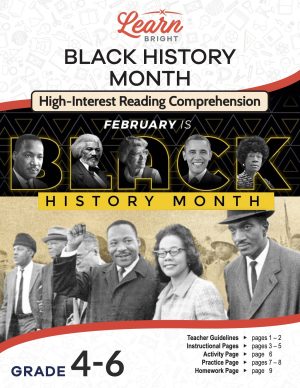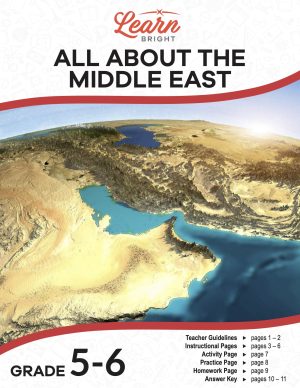Description
What our Expressions and Formulas lesson plan includes
Lesson Objectives and Overview: Expressions and Formulas teaches students how to evaluate expressions and solve problems using given formulas. At the end of the lesson, students will be able to evaluate expressions at specific values of their variables. This lesson is for students in 6th grade.
Classroom Procedure
Every lesson plan provides you with a classroom procedure page that outlines a step-by-step guide to follow. You do not have to follow the guide exactly. The guide helps you organize the lesson and details when to hand out worksheets. It also lists information in the blue box that you might find useful. You will find the lesson objectives, state standards, and number of class sessions the lesson should take to complete in this area. In addition, it describes the supplies you will need as well as what and how you need to prepare beforehand.
Options for Lesson
Included with this lesson is an “Options for Lesson” section that lists a number of suggestions for activities to add to the lesson or substitutions for the ones already in the lesson. A few optional adjustments or additions to the lesson activity include increasing the number of expressions students are to create and having students create word problems to match the expressions they create. Students can also exchange their created expressions and have other students solve them using selected numbers for the variables. For an additional lesson activity, you could distribute geometric shapes like triangles and rectangles and have your students measure the lengths, widths, and radii and find the areas, perimeters, circumference and other measurements using the formulas.
Teacher Notes
The teacher notes page includes a paragraph with additional guidelines and things to think about as you begin to plan your lesson. This page also includes lines that you can use to add your own notes as you’re preparing for this lesson.
EXPRESSIONS AND FORMULAS LESSON PLAN CONTENT PAGES
Expressions and Formulas
The Expressions and Formulas lesson plan includes two content pages. Students are likely already familiar with algebraic expressions and formulas that contain both ordinary numbers and variables. These expressions include one or more operations, like addition, subtraction, multiplication, or division. They may also include exponents or roots.
We can write expressions as phrases first before translating them directly into algebraic expressions. For example, a number plus four can be written as A + 4, three less than a number as X – 3, half of a number as 1/2Y, and seven times a number as 7B. We can then replace the variable with a number and solve.
Sometimes we use expressions to solve real-world problems. For example, you can use an expression to determine the amount of money that children who receive a weekly allowance will receive each month or year. We can represent the amount of the allowance with a variable, like x. The expression that we would use to figure out a weekly allowance is 4x, because there are four weeks in a month. The expression to figure out a yearly allowance is 52x, because there are 52 weeks in a year.
Next, we can solve the expressions using specific values for the variables. If you received a weekly allowance of $12, we would substitute 12 for x in each expression. 4(12) = 48, so the monthly allowance is $48. 52(12) = 624, so the annual allowance is $624.
Many formulas are expressions, like the area of a rectangle. The formula for the area of a rectangle is lw, which means length times width. It’s an expression used as a formula. If you know the length and width of a rectangle, you can use the formula to figure out its area. Some other formulas are the volume (V = s3 ) and surface area (SA = 6s2 ) of a cube.
Others include the area of a triangle (A =½(bh)), area of a circle (πr2), rectangle perimeter (2 (l + w)), area of a square (s2), circumference of a circle (2πr), and perimeter of a square (4s).
You can solve many math, geometry, and algebra formulas by replacing the variables with specific values. For example, if you know that a triangle has a base measuring 6 inches and a height of 12 inches, you can find its area by using the formula and expression above: A = ½(6)(12) = ½ (72) = 36 sq. in.
All you need to do is replace the variables with specific values and solve. You also need to make sure to follow the order of operations. Start by working within the parenthesis, then exponents, multiplication/division, and addition/subtraction.
EXPRESSIONS AND FORMULAS LESSON PLAN WORKSHEETS
The Expressions and Formulas lesson plan includes three worksheets: an activity worksheet, a practice worksheet, and a homework assignment. You can refer to the guide on the classroom procedure page to determine when to hand out each worksheet.
CREATING EXPRESSIONS ACTIVITY WORKSHEET
Students will work with a partner to complete the lesson activity. Each pair will first cut out the numbers, variables, operation signs, fraction bars, and parentheses printed on the worksheet. They will then use them to create 10 expressions, which they will write out using the chart. Next, they will replace the variables with numbers and solve.
EVALUATE EXPRESSIONS PRACTICE WORKSHEET
For the practice worksheet, students will evaluate eight expressions by replacing the variables with the given values, making sure to show their work. They will also use the gives formulas and variables to solve 16 additional expressions.
EXPRESSIONS AND FORMULAS HOMEWORK ASSIGNMENT
The homework assignment asks students to read and solve six word problems that include expressions with variables.
Worksheet Answer Keys
This lesson plan includes answer keys for the practice worksheet and the homework assignment. If you choose to administer the lesson pages to your students via PDF, you will need to save a new file that omits these pages. Otherwise, you can simply print out the applicable pages and keep these as reference for yourself when grading assignments.









